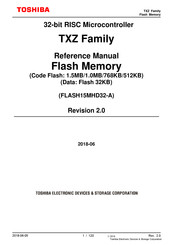TOSHIBA TXZ Manuals
Manuals and User Guides for TOSHIBA TXZ. We have 1 TOSHIBA TXZ manual available for free PDF download: Reference Manual
TOSHIBA TXZ Reference Manual (120 pages)
32-bit RISC Microcontroller
Brand: TOSHIBA
|
Category: Microcontrollers
|
Size: 3.63 MB
Table of Contents
Advertisement
Advertisement
